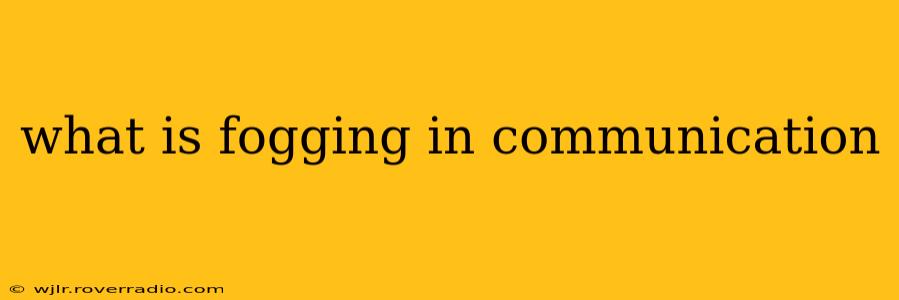Fogging, in the context of communication, is a powerful technique used to defuse conflict and avoid getting drawn into arguments. It's a non-defensive response strategy that acknowledges the other person's perspective without necessarily agreeing with it. Instead of directly confronting or contradicting a statement, fogging involves agreeing with a portion of what's said while remaining neutral on the overall point. This approach allows you to de-escalate tense situations and maintain a calm, respectful dialogue. Think of it as a skillful way to navigate disagreements by selectively agreeing with aspects of the critique while maintaining your own position.
How Does Fogging Work?
Fogging relies on several key components:
-
Partial Agreement: You identify and agree with a part of the other person's statement that is factually true or at least neutral. This shows you've listened and understood their perspective. Avoid agreeing with the core complaint or accusation, however.
-
Neutral Response: Your response should remain neutral and avoid emotional reactivity. This prevents the conversation from escalating into a confrontation. The goal isn't to win the argument, but to manage it constructively.
-
Avoidance of Direct Denial: Fogging deliberately avoids directly denying the other person's statements. Direct denial can be perceived as confrontational and can inflame the situation.
-
Focus on Facts: Ground your response in objective facts, rather than subjective opinions or interpretations. This reduces the potential for misinterpretations and misunderstandings.
Examples of Fogging in Action
Let's look at some examples to illustrate how fogging works in different scenarios:
Scenario 1: A colleague says, "Your presentation was disorganized and boring."
Fogging Response: "You're right, I could have organized the information differently. I understand that presentations need to engage the audience better." (This acknowledges the criticism of organization without agreeing that the presentation was entirely boring.)
Scenario 2: A customer complains, "This product is completely useless!"
Fogging Response: "I understand your frustration. It sounds like it didn't meet your expectations. Can you tell me more about what wasn't working for you?" (This acknowledges the customer's dissatisfaction without agreeing that the product is completely useless.)
Scenario 3: A friend says, "You're always so negative!"
Fogging Response: "It's true, I've been feeling down lately. I'm working on it." (This acknowledges the negativity without necessarily accepting the "always" aspect.)
What are the Benefits of Using Fogging?
-
Reduces Conflict: Fogging helps to defuse tense situations by preventing direct confrontation.
-
Encourages Collaboration: By acknowledging the other person's perspective, you create space for collaboration and finding mutually agreeable solutions.
-
Builds Rapport: Showing that you've listened and understood the other person's point of view can build rapport and trust.
-
Maintains Control: Fogging allows you to maintain control of your emotional response and prevents you from being pulled into an unproductive argument.
-
Improves Communication: Fogging encourages clearer and more effective communication by promoting mutual understanding.
Why is Fogging an Effective Communication Technique?
Fogging is effective because it addresses the concerns of the other person without validating their potentially inaccurate or unfair criticisms. It allows for a more productive discussion by focusing on shared understanding rather than fueling disagreement. This method is particularly valuable in situations where emotional reactions might hinder productive communication.
Is Fogging Manipulation?
While it might seem manipulative at first glance, fogging is not inherently so. It's a communication technique used to navigate difficult conversations constructively. The key is to use it ethically and honestly, focusing on genuine acknowledgement and understanding rather than attempting to deceive or control the other person. If used with a sincere desire for understanding and resolution, fogging can be a valuable tool in building positive relationships and resolving conflict.
What are some alternative communication techniques?
While fogging is a powerful technique, other approaches can also help resolve communication issues. These include active listening, empathy, and assertive communication. The best approach depends on the specific context and the nature of the disagreement.
How can I improve my fogging skills?
Practice is key to mastering fogging. Start by practicing in low-stakes situations, gradually working your way up to more challenging conversations. Pay attention to your nonverbal cues, ensuring they align with your calm and neutral verbal response. Remember that sincerity is crucial; fogging should never feel disingenuous.
